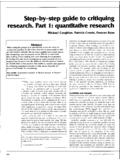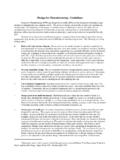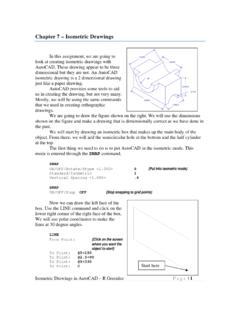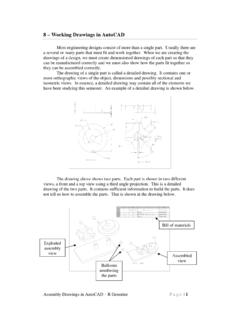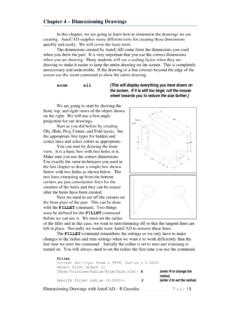Transcription of Exercise Motivation: What Starts and Keeps People ...
1 Exercise Motivation: What Starts and Keeps People Exercising? Len Kravitz, Although extolling all the benefits of Exercise seems impressive, it is apparent that this approach by itself does not assure consistent Exercise compliance for most individuals. Regular Exercise is a complex, multi-factorial behavior that Exercise professionals and scientists need to better understand, in order to help clients stay active and healthy. Research suggests that 50% of persons starting an Exercise program will drop out within the first 6 months (Wilson and Brookfield, 2009). This column will update what is now known about Exercise adherers and dropouts, and describe some strategies Exercise professionals can utilize with clients, to help them stay on path with their fitness program.
2 What is the Process that Leads to Exercise Participation? According to Whaley and Schrider (2005), how People view themselves, from past experiences to current reality, will soundly influence their choice for physical activity. A person's sense of self-perception plays a major role in whether she/he will start an Exercise program. So, even if for medical reasons a person has been encouraged to Exercise , his/her own self-perception may impede this from happening. In fact, some People may view themselves as incompetent without ever trying to Exercise . Whatley and Schrider highlight that a person's future hopes may also motivate them to Exercise . For instance, if a person wishes to be independent in older adulthood, he/she may begin an Exercise program and stay physically active to reach that goal.
3 Whaley and Schrider assert that research consistently shows that positive feedback (from Exercise professionals), reinforcement (that Exercise is worthy and beneficial) and social support (from significant others) will improve a person's self-perception to initiate an Exercise program (See Figure 1). Figure 1. Self-Regulatory Strategy to Initiate an Exercise Program What Motivates People to Continue to Exercise ? Trost et al. (2002) completed an exhaustive review of the correlates of participation and adherence to Exercise : They followed previous research review designs in designating the following major categories: a) demographic and biological factors, b). psychological, cognitive and emotional factors, c) behavioral attributes and skills, d).
4 Social and cultural, and e) physical environment and/or physical activity characteristics. a) Demographic and biological factors: Trost et al. note that the research indicates that men are more involved than women in physical activity. Moreover, being overweight and/or obese consistently proves to be negatively associated with Exercise adherence. b) Psychological, cognitive and emotional factors: The primary psychological factor associated with Exercise adherence is a person's physical self-efficacy (Trost et al., 2002). Self-efficacy is a person's confidence in her/his ability to do Exercise and be consistent with workouts. Huberty et al. 2008 propose that high self-efficacy is particularly important with women adherers to Exercise .
5 The authors add that self-worth ( , the foundations of a person's specific values about Exercise ) is also an important factor to Exercise adherence in women. The more People think they can successfully do Exercise signifies they will more likely adhere to the Exercise program. Exercise adherers demonstrate an intrinsic (incentive to Exercise based on the expected enjoyment). motivation to Exercise (Huberty et al.). The influence of the Exercise professional in empowering clients that they can succeed with Exercise ' is vitally important to Exercise compliance. Designing programs where the client is successful' doing the exercises is essential. This is a unique validation for the concept of individualized Exercise programs.
6 C) Behavioral attributes and skills: More research is necessary to determine what other behaviors (such as diet, sleep, smoking, alcohol use, etc) are associated (or not linked). with Exercise adherence. It appears there is a positive association with a healthy diet and Exercise adherence. Seguin et al. (2010) observe that the affirmative health-related outcomes People detect and appreciate from an Exercise program are a principal catalyst to continue exercising. It is key to acknowledge that these outcomes often take months to truly realize after the initiation of the fitness program. Huberty et al. (2008) state that Exercise adherers seek a high quality of life and prioritize special time in their schedule to be physically active: I am going to my personal training session because I want to, it makes me feel good, and I'm worth the time.
7 The authors continue that enjoying how Exercise improves their quality of life is a major motivating factor to keep exercising. Specific knowledge of the actual gains in fitness is quite motivating to many individuals and increases their competence to Exercise and continue exercising. Thus, doing assessments and reporting improvements is critically important to encouraging a client to continue exercising. Whatley and Schrider note that positive feedback and knowledgeable guidance from an Exercise professional, within a supportive Exercise atmosphere, is also consequential to Exercise compliance. With proficiency of Exercise People develop confidence that they can reach new, more specific and challenging goals, and thus will set these new goals into action plans (with the help of their personal trainer).
8 D) Social and cultural: Numerous studies show that social support from a significant other or meaningful friend is highly associated with Exercise adherence (Trost et al., 2002). With Exercise professions, group Exercise programs routinely help to build these social support networks. With personal trainers, the concept of small group training, cardio clubs, boot camps and fitness workout camps are excellent programs for enhancing adherence with exercisers. e) Physical environment and/or physical activity characteristics: It appears that easy access to Exercise facilities enhances Exercise adherence (Trost et al., 2002). As well, satisfaction with the workout facility ( , perceived safe equipment and facilities, which is user friendly to operate) is also highly associated with Exercise adherence.
9 Interestingly, watching others Exercise also helps to motivate People to continue with their own Exercise plan. Seguin et al. (2010) emphasize that there is a significant relation in a client's Exercise adherence with his/her personal trainer's leadership style. The authors continue that Exercise leaders who are perceived to have a high mastery of Exercise (developed from their own training, Exercise habits and lifestyle) favorably influences client Exercise adherence. Thus, Exercise professionals may be esteemed role models for their clients (See Figure 2 for other Exercise professional characteristics associated with client Exercise adherence). Figure 2. Exercise Professional Characteristics Associated with Client Exercise Adherence What Do We Know About Exercise Dropouts?
10 People who over-estimate their expectancies from Exercise are most likely to drop out (Whaley and Schrider, 2005). Thus a person who expects to lose a lot of weight from Exercise , and does not, is likely to drop out from the Exercise program. The message here denotes how pivotal realistic' weight loss goals presented in an attainable' timeline'. (See Figure 1 for all goals) are imperative to helping a person stay with the Exercise program. Common barriers to Exercise are shown in Figure 3. Perhaps not surprising, but confirmed in the research, is that People who smoke are less likely to adhere to an Exercise program (Trost et al., 2002). Furthermore, a person with low self- worth ( , self-doubt, insecure, negative self talk) and poor body image is more likely to be an Exercise dropout (Huberty et al.)


